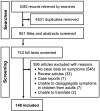The prevalence of symptoms in 24,410 adults infected by the novel coronavirus (SARS-CoV-2; COVID-19): A systematic review and meta-analysis of 148 studies from 9 countries
- PMID: 32574165
- PMCID: PMC7310678
- DOI: 10.1371/journal.pone.0234765
The prevalence of symptoms in 24,410 adults infected by the novel coronavirus (SARS-CoV-2; COVID-19): A systematic review and meta-analysis of 148 studies from 9 countries
Abstract
Background: To limit the spread of SARS-CoV-2, an evidence-based understanding of the symptoms is critical to inform guidelines for quarantining and testing. The most common features are purported to be fever and a new persistent cough, although the global prevalence of these symptoms remains unclear. The aim of this systematic review is to determine the prevalence of symptoms associated with COVID-19 worldwide.
Methods: We searched PubMed, Embase, CINAHL, AMED, medRxiv and bioRxiv on 5th April 2020 for studies of adults (>16 years) with laboratory test confirmed COVID-19. No language or publication status restrictions were applied. Data were independently extracted by two review authors into standardised forms. All datapoints were independently checked by three other review authors. A random-effects model for pooling of binomial data was applied to estimate the prevalence of symptoms, subgrouping estimates by country. I2 was used to assess inter-study heterogeneity.
Results: Of 851 unique citations, 148 articles were included which comprised 24,410 adults with confirmed COVID-19 from 9 countries. The most prevalent symptoms were fever (78% [95% CI 75%-81%]; 138 studies, 21,701 patients; I2 94%), a cough (57% [95% CI 54%-60%]; 138 studies, 21,682 patients; I2 94%) and fatigue (31% [95% CI 27%-35%]; 78 studies, 13,385 patients; I2 95%). Overall, 19% of hospitalised patients required non-invasive ventilation (44 studies, 6,513 patients), 17% required intensive care (33 studies, 7504 patients), 9% required invasive ventilation (45 studies, 6933 patients) and 2% required extra-corporeal membrane oxygenation (12 studies, 1,486 patients). The mortality rate was 7% (73 studies, 10,402 patients).
Conclusions: We confirm that fever and cough are the most prevalent symptoms of adults infected by SARS-CoV-2. However, there is a large proportion of infected adults which symptoms-alone do not identify.
Conflict of interest statement
The authors have declared that no competing interests exist.
Figures



References
-
- Coronavirus disease 2019 (COVID-19) Situation Report– 81. World Heal. Organ. 2020.
Publication types
MeSH terms
Grants and funding
LinkOut - more resources
Full Text Sources
Other Literature Sources
Medical
Miscellaneous

